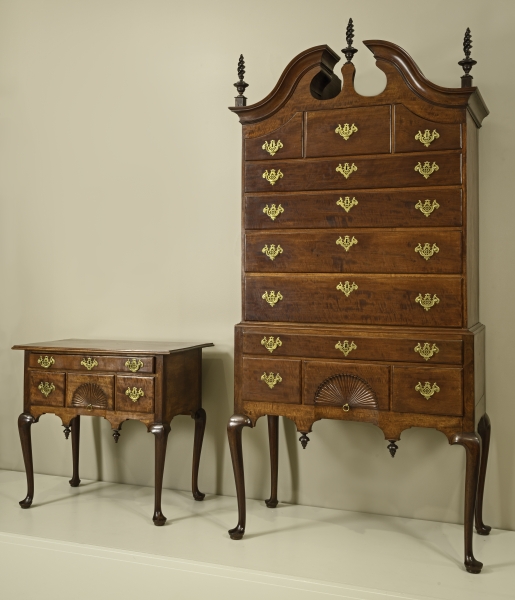· 8 ·
“Such Ruins Were Never Seen in America”:
The Looting of Thomas Hutchinson’s House at the Time of the Stamp Act Riots
JOHN W. TYLER
Boston was rife with rumors, backbiting, and fears of impending disaster during the summer of 1765. The Stamp Act, the most egregious invasion of traditional colonial liberties that Parliament had yet threatened, was due to take effect on November 1. The tax on all legal documents would reach directly into the pockets of anyone who had business at either the courts or the customshouse.
Who was to blame? On August 16, a crowd had leveled the newly constructed counting house of Andrew Oliver, the province secretary and stamp distributor, before proceeding to hurl brickbats through the windows of his nearby house. Thomas Hutchinson, Oliver’s brother-in-law and the lieutenant governor of Massachusetts, had long stood high in the people’s regard, but in recent years his name had become increasingly associated with efforts to curtail colonial rights. As chief justice, he had upheld the power of the superior court to issue writs of assistance (general search warrants) to customs officials and naval officers. When the Massachusetts House of Representatives framed a fiery petition against the Stamp Act, Hutchinson used his position as president of the provincial council (the upper house of the legislature) to block its passage and substituted much more restrained language in its place.
We now know from his letters that Hutchinson never favored the Stamp Act; he had even written privately to several highly placed persons in England warning against it. Yet, people wanted scapegoats, and on the night of August 26, a crowd attacked his North End mansion with unmitigated fury (fig. 1). As Hutchinson himself described it:
In the evening whilst I was at supper and my children round me somebody ran in and said the mob were coming. I directed my children to fly to a secure place and shut up my house. . . . and withdrew . . . to a neighbouring house where I had been but a few minutes before the hellish crew fell upon my house with the Rage of devils and in a moment with axes split down the door and entred. . . . Some ran immediately as high as the top of the house others filled the rooms below and cellars and others Remained without the house to be employed there. . . . I was obliged to retire thro yards and gardens to a house more remote where I remained until 4 o’clock by which time one of the best finished houses in the Province had nothing Remaining but the bare walls and floors.1
The looters were extraordinarily thorough:
Not contented with tearing off all the wainscot and hangings and splitting the doors to pieces they beat down the partition walls and altho that alone cost them near two hours they cut down the cupola or lanthern and they began to take the slate and boards from the roof and were prevented only by the approaching day light from a total demolition of the building. The garden fence was laid flat and all my trees &c. broke down to the ground. Such ruins were never seen in America. Besides my plate and family pictures houshold furniture of every kind my own my children and servants apparel they carried off about £900— sterling in money and emptied the house of every thing whatsoever except a part of the kitchen furniture not leaving a single book or paper in it and have scattered or destroyed all the manuscripts and other papers I had been collecting for 30 years together besides a great number of publick papers in my custody.2
Over the next few weeks, thousands came from the countryside to gawp at what the fury of the mob had wrought. And though the Boston town meeting immediately passed a resolution condemning the attack, efforts to apprehend the principals were met with a stony, almost conspiratorial silence.
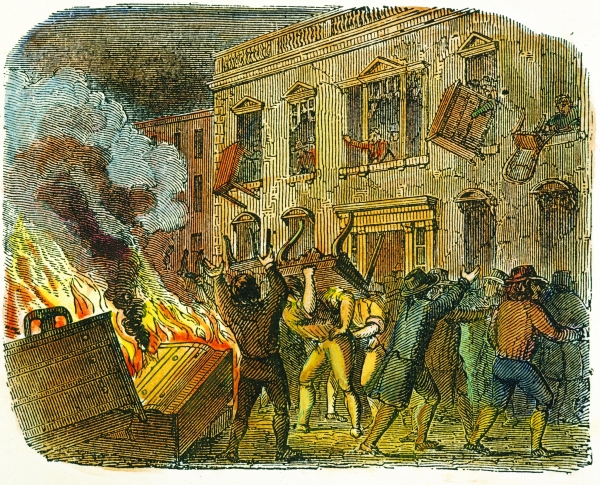
FIG. 1. Sons of Liberty Protesting the Stamp Act by Attacking the House of Lieutenant Governor Thomas Hutchinson at Boston on 26 August 1765, John Warner Barber (1798–1885), mid-19th century. Wood engraving. Granger Collection, New York.
Despairing of his chances of reimbursement from either the town or the province, Hutchinson formally applied to the crown to make good on his losses. He accompanied his letter to the secretary of state with an eight-page inventory of cash, furniture, and apparel totaling £2,218.3 A remarkable document, the inventory lists the contents of each room as well as the clothes belonging to the twelve residents of the house. This inventory differs from standard probate inventories by including little or no information about the less valuable objects Hutchinson owned, though it includes significantly more descriptive information about his more valuable objects. It is also unusual to have such details about the clothing of both his family and his servants. From this document, it is possible to reconstruct how each room functioned, as well as the varying status of each of the inhabitants.
But first a word about the house. Hutchinson’s three-story mansion was in all likelihood built by his maternal grandfather, Colonel John Foster, in 1689–92 on Garden Court Street, a short street that still exists and leads from North Square (the site of the Paul Revere House) to Hanover Street, the principal thoroughfare of the North End (fig. 2).4 By the 1760s, the North End had become one of the town’s poorest sections, home to seafarers and the accompanying maritime trades. Contemporary perspective views of Boston from the harbor show Hutchinson’s house and the adjoining Clark-Frankland house lording over the surrounding two-story frame dwellings of their neighbors (identified as no. 33 in fig. 3). Our only knowledge of the structure’s exterior comes from a February 1836 illustration in The American Magazine of Useful & Entertaining Knowledge (fig. 4). Its narrow, upright proportions of contrasting red brick and the Portland stone facade constitute a provincial echo of the robust seventeenth-century neo-Palladianism of Inigo Jones and Christopher Wren, filtered through a lens of artisan mannerism. The dimensions of the house were fifty feet by forty, making it slightly larger than the Isaac Royall house in nearby Medford, Massachusetts (1733–50).5 The Foster-Hutchinson house was destroyed in 1833; the only vestige (now owned by Historic New England) is one of the ornate capitals from the facade’s four giant pilasters. The 1836 engraving also fails to include the “lanthorn,” or cupola, mentioned by Hutchinson in his account of the riot; it must have further underscored the baroque aspect of the dwelling. Similar cupolas appear on the Jeremiah Lee house in Marblehead, Massachusetts (1768), and on the Macpheadris-Warner house in Portsmouth, New Hampshire (1718–23).
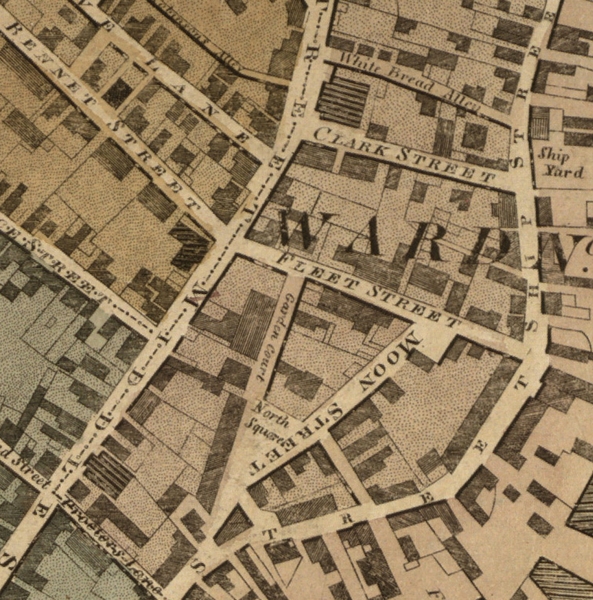
FIG. 2. Detail of Map of Boston in the State of Massachusetts, surveyed by John Groves Hales (1785–1832), engraved by Thomas Wightman Jr. (1782–1820), Boston, 1814. Engraving on laid paper; h 36¼, w 28⅜. The Norman B. Leventhal Map Center at the Boston Public Library. Hanover Street in Hutchinson’s time is identified on this later map as Middle Street.
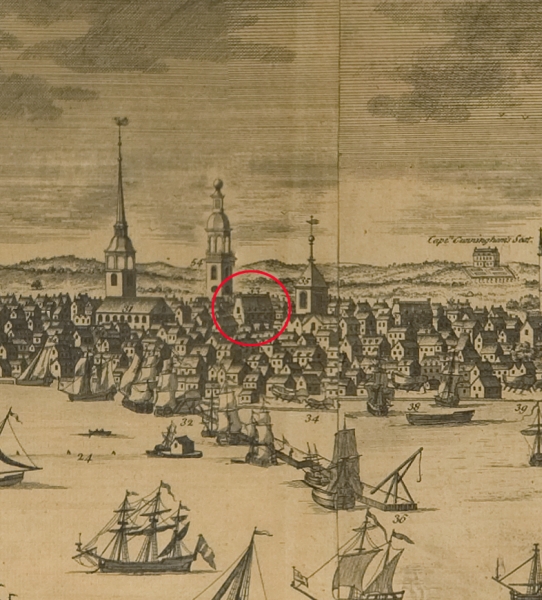
FIG. 3. Detail from the 1743 edition of A South East View of Ye Great Town of BOSTON in New England in America, created by William Burgis (active 1722–36), engraved by John Harris (active 1680–1740), Boston, 1725. Engraving on laid paper; h 23½, w 51¾. American Antiquarian Society. The Hutchinson and Clark-Frankland houses stood so close together that they are jointly identified here as no. 33.
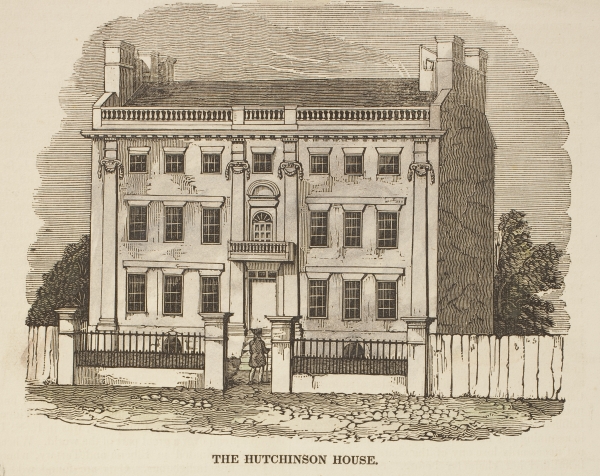
FIG. 4. The Hutchinson House. From The American Magazine of Useful & Entertaining Knowledge (February 1836): 237. Photo, Historic New England.
Before discussing the floor plan and the contents of each room, it may be helpful to note three aspects of the inventory that may not surprise historians of material culture but might puzzle other readers: the high relative cost of textiles, the plethora of chairs, and the paucity of silver plate. In an era of hand weaving, textiles were often the most expensive items in probated estates, and so they were at Hutchinson’s house. He valued the bed hangings in the “great chamber” at £50 while assigning his desk and bookcase a worth of only £7.6
Hutchinson’s house, which probably had somewhere between fifteen to twenty rooms, contained more than sixty chairs ready to be brought forward for a variety of purposes. These included several sets of cane-bottomed chairs more typical of the late seventeenth century (fig. 5). Hutchinson’s collection of silver plate (valued at £64) was relatively modest, with silver flatware for barely a dozen (plus a similar number of dessert knives and forks; fig. 6). Nor did Hutchinson appear to own many larger pieces of plate: only a one-quart tankard, a set of castors, and a “large handsome coffee pot” valued at £16. This last item was clearly a source of particular pride, for Hutchinson bitterly recorded that its top was later “found beat up, or as the mob term it, stamped.” Perhaps he and his family removed as much silver as they could carry in their flight. An English teapot now at the Massachusetts Historical Society might be just such an item, since no silver teapot was included in the inventory (fig. 7). More probably, if this is indeed an object that Hutchinson once owned, it was a replacement purchased after the looting or taken from his country house in Milton.
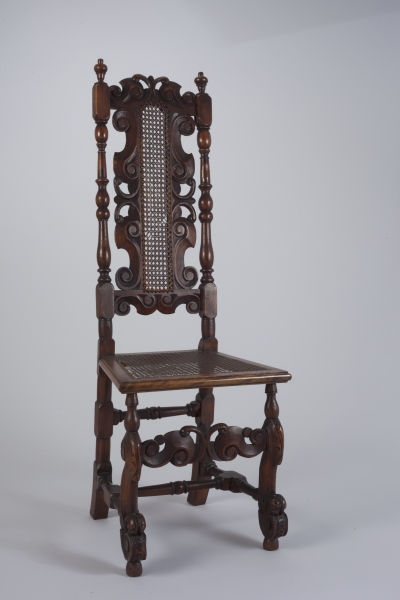
FIG. 5. Side chair, London, 1700–1715. Beech, cane; h 51, w 18½, d 15⅞. Historic New England; Bequest of Mrs. Woodbury (Elizabeth Elwyn) Langdon (1966.287).
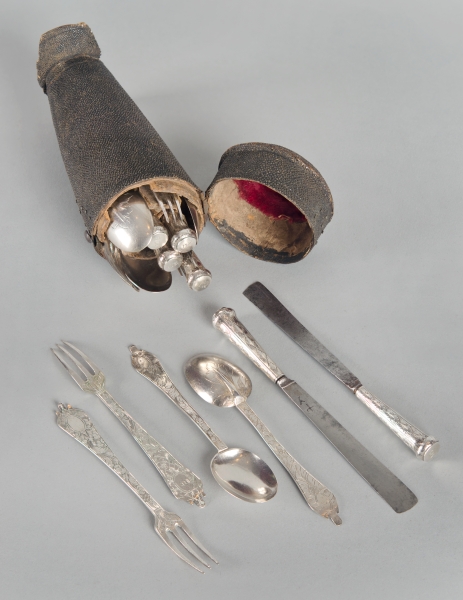
FIG. 6. Set of sweetmeat knives, forks, and spoons in a case, probably London, 1690–1700. Silver, steel, shagreen; l knife 5⅛. Collections of the Massachusetts Historical Society (0296.01–08).
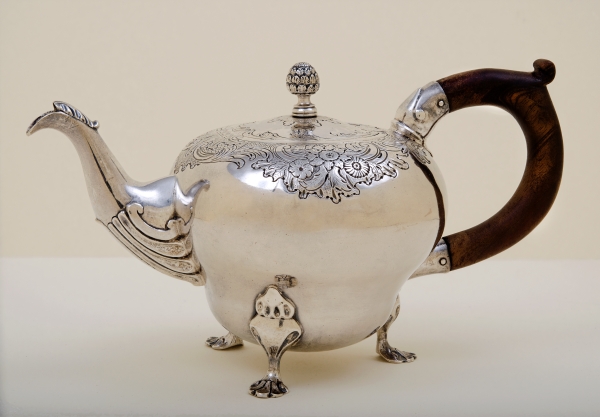
FIG. 7. Teapot, attributed to Richard Rugg (free 1746), London, ca. 1754. Silver; h 5¼, w 9½. Collections of the Massachusetts Historical Society (0297).
The first floor of the Foster-Hutchinson house followed a typical eighteenth-century plan. One entered through a central passage, which may or may not have run all the way through the house but certainly contained a massive staircase leading to the second floor (fig. 8). Lydia Maria Child, who may have visited the house as a young girl, described the space in her novel The Rebels, or Boston before the Revolution as “display[ing] a spacious arch, richly carved and gilded, in all the massy magnificence of the time, and most tastefully ornamented with busts and statues.”7 Although busts and statues were a prominent feature of the house, they were in what Hutchinson calls “the hall,” or dining room, and not “the entry,” his word for the central passage Child described. The entry was minimally furnished with an interior hanging lantern, a large walnut table, and a dozen cane chairs, in which clients and petitioners might sit cooling their heels while waiting to be ushered in to see the great man.
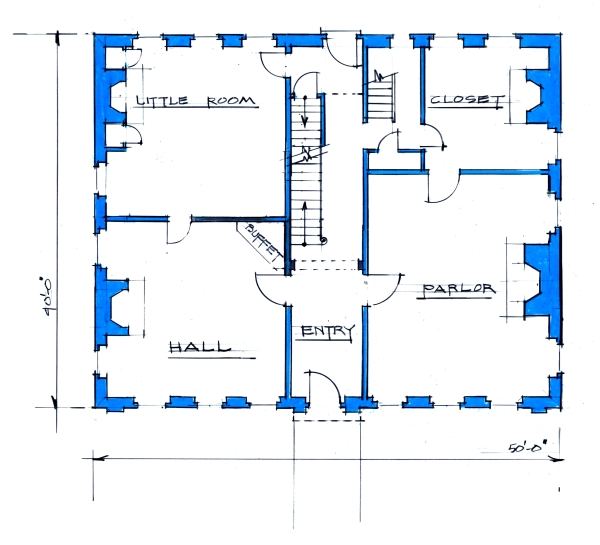
FIG. 8. Conjectural plan of the first floor of the Foster-Hutchinson house. Drawing, Paul Kelly.
On either side of the entry were the parlor and the hall. In seventeenth-century New England, the hall would have been the principal room for the family, used for cooking, eating, and huddling next to the one fire that might be burning constantly. The parlor was more often reserved for entertaining, although it might also serve as an everyday sitting room or even a best bedchamber. Throughout the eighteenth century, meals might have been served in almost any room of the house, with servants setting up tables and chairs as needed. The Hutchinson inventory makes clear that by 1765, both the parlor and the hall had acquired more specialized, modern uses (table 1).
TABLE 1. RELATIVE VALUE OF FURNITURE PER ROOM
|
Parlor and Closet |
131..3 |
|
Hall and Buffet |
56..19..4 |
|
Little Room |
45..9..4 |
|
Entry |
10.. |
|
Great Chamber |
120..2 |
|
Hall Chamber |
41.. |
|
Back Chamber |
5..16 |
|
My Lodging Chamber |
20..13..4 |
|
Upper Entry |
4..10 |
With contents valued at over £131, the parlor (table 2) was the mansion’s most lavishly furnished room, designed to impress guests with the family’s history and its affluence. The types of furnishings suggest that the space was used as a drawing room (as the older sitting room—withdrawing room—function came to be called). Its walls were hung with “2 large family pictures [in] gilt frames”; there were also two smaller portraits of “my grandfather and mother” and “4 large prints newly framed and glazed.” The seating included “a handsome couch,” with “bed and pillar for the couch.” (By “bed,” Hutchinson means an upholstered pad to sit on, and the “pillar” would be a pillow, or cushion, for the back [fig. 9]). The room also contained a large walnut table and a dozen “new” walnut chairs, which seemed to be fitted out with loose, striped satin cushions (fig. 10). Not surprisingly, the family owned a tea table and an incomplete set of “burnt china”8 as well as a “large turkey carpet.”
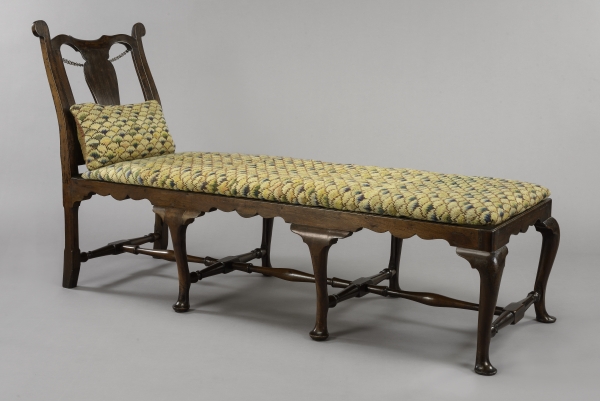
FIG. 9. Couch or daybed, probably Boston, 1730–60. Black walnut, soft maple; h 38, w 23¾, d 68⅝. Winterthur Museum; Bequest of Henry Francis du Pont (1958.2223).
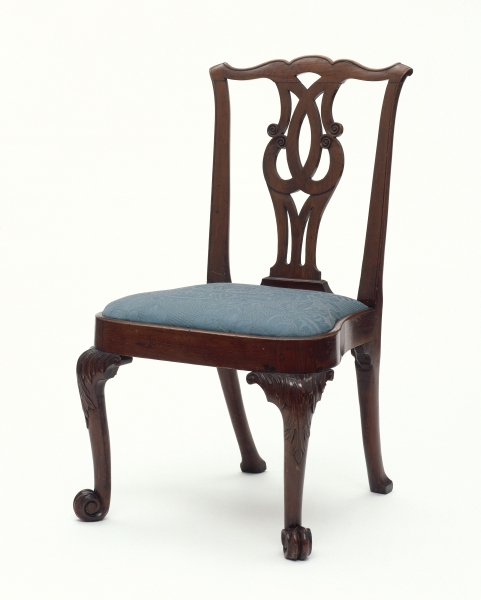
FIG. 10. Side chair, Hingham, Mass., area, 1765–80. Black walnut, maple; h 36¾, w 20½, d 17⅞. Museum of Fine Arts, Boston; Gift of Edward Jackson Holmes (RES.41.66). “New” walnut chairs might have had pierced splats and serpentine crests like this chair, or they may have followed a more traditional pattern (see fig. 8).
|
a tea table & burnt china tea set incompleat |
5..10 |
|
12 new walnut chairs all lost except some bottoms |
11.. |
|
a large walnut table |
3..10.. |
|
a handsome couch |
3..10.. 7.. |
|
a bed & pillar for the couch & a dozen of cushions stuffed with feathers & covered with striped sattin |
14.. |
|
2 large family pictures gilt frames |
20.. |
|
2 smaller size my grandfather & mother |
16.. |
|
4 large prints newly framed and glazed |
6.. |
|
Andirons shovel & tongs brass |
4.. |
|
large turky carpet |
8.. |
Adjoining the parlor was a space Hutchinson describes as “the closet,” or small study. The Macpheadris-Warner house contains a similar space, sandwiched between two principal rooms on one side of the stair hall. Although Hutchinson’s closet seems to have been principally filled with china and pewter, it also contained “two sconces on either side of the fireplace,” which suggests that it was indeed a separate room and not a closet in the modern sense (a windowless space for storage). In a 1964 article, Abbott Lowell Cummings cites additional evidence supporting the idea of a separate room, quoting Cotton Mather’s description of Hutchinson’s grandmother, Sarah Foster, a woman of such devout piety that she retired regularly to her “closet” to pray, sometimes spending the entire day there.9
On the other side of the entry was the “hall,” no longer a multipurpose room by Hutchinson’s time; the list of furnishings makes clear it was used just for dining (table 3). Two “large sconces with arms” provided lighting, with the two large and two smaller mahogany tables combined in various ways as dictated by the number of guests. For seating, there were eight chairs upholstered with rare and expensive Morocco leather. Three painted oilcloths covered the floor, and nine glazed prints hung on the walls. The presence of a Dutch teakettle and stand, as well as a japanned tea chest, suggest that tea might have been taken in the hall as well as in the parlor. But the most unique feature of the room was “5 large busts on the mantle piece” worth 10 shillings.
TABLE 3. HALL
|
2 large sconces with arms |
12.. |
|
2 square mahogony tables |
5.. 6..8 |
|
2 smaller 4.. |
9.. 6..8 |
|
3 painted oyl clothes 36/ 2 large glazed prints 50/ |
4.. 6 |
|
7 glazed prints |
2..10 |
|
8 chairs morocco leather |
9..11.10 |
|
5 large busts on the mantle piece at 10/sterl. |
3..6..8 |
|
handsome andirons, shovel & tongs |
5.. |
|
Dutch tea kettle & stand & japand tea chest |
2.. |
When Thomas Hutchinson Jr. traveled to London in the spring and summer of 1766 to press his father’s case for compensation, Hutchinson Sr. ordered him to purchase a “Doz. and a half busts of yellow bronze half as big as those that were in the hall.” As possible subjects for the busts, Hutchinson suggested “Cicero Horace Virgil Julius Cæser Augustus Pliny Junior Erasmus Milton Tillotson Addison Pope Locke Shakespeare [and] Gay” but told his son to “make up the number such as you fancy including one of the King,” so long as they cost no more than three or four shillings each.10 In colonial America, such busts of classical figures could have found their way into any wealthy household with literary pretensions, but Hutchinson’s contemporary choices are more interesting. John Gay was the author of The Beggar’s Opera (1728), one of the most popular satirical dramas of the early eighteenth-century London stage. Macheath, its highwayman-hero, was commonly regarded to be a stand-in for Sir Robert Walpole, the leading cabinet member from 1721 to 1742 and a byword for corrupt politics of the sort that Hutchinson was often accused. The other curious choice is Archbishop John Tillotson (1630–1694), a giant of the Latitudinarian wing of the Anglican church, who believed that reason, guided by the Holy Spirit, provided a surer guide to conduct than theological niceties. Hutchinson, although a lifelong member of the Congregational church into which he was born, often attended Anglican services as governor. His admiration of Tillotson may suggest where his real religious sympathies lay.
In his inventory, Hutchinson attached the contents of the “buffet” with those of the hall in much the same way as he had combined those of the parlor and the closet. But here, “buffet” probably signifies a built-in cupboard for the storage of silver and china, sometimes called a “bowfat” in eighteenth-century parlance. Buffets often had an arched opening and lockable doors that could be opened for visual display when entertaining but otherwise secured for safe-keeping. Note that in the Hutchinson inventory, however, the contents of the hall and buffet were worth only £56, less than half the value of the parlor and closet.
Hutchinson named the last room on the first floor the “little room,” and he appears to have used it as an office or study (table 4). There, he kept his “desk and shelves,” or secretary, as well as a round table and six chairs with turkey-work bottoms (fig. 11).11 Hutchinson appears to have particularly regretted the loss from this room of a “very good clock,” worth £12, noting that “both clock & case broke to pieces & destroyed.”
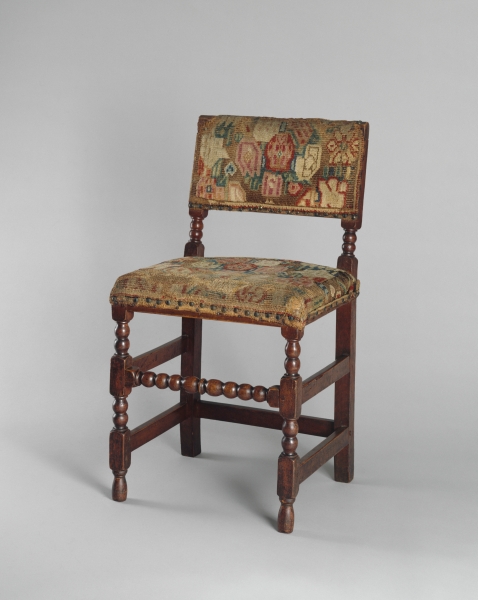
FIG. 11. Side chair with original turkey-work upholstery, Boston, 1660–90. Beech, hard maple, white oak; h 37⅛, w 20½, Seat d 17. Metropolitan Museum of Art; Gift of Mrs. J. Insley Blair (52.77.51). Hutchinson’s reference to turkey work suggests that the chairs dated from the late seventeenth century, when this woven English imitation of Near Eastern carpets enjoyed widespread popularity for upholstery.
TABLE 4. LITTLE ROOM
|
6 walnut chairs turky work bottoms & 1 great chair |
9.. |
|
small chairs 10/ very handsom table 48/ |
2..18 |
|
walnut desk & shelves & window cushion |
7.. |
|
round table 18/. polish’d andirons shovel &c. 4 |
4..18 |
|
a large sconce mahogony frame |
6..13..4 |
|
a very good clock, both clock & case broke to pieces & destroyed |
12.. |
|
a canvas floor cloth new painted |
3.. |
Over the years, several pieces of furniture have gathered an association with Hutchinson, some on dubious authority; none has an undisputed provenance. Historic New England owns a tall-case clock that, according to family tradition, “was thrown into the streets of Boston when his [Hutchinson’s] house was mobbed, August 26, 1765.” Although the case was probably made sometime between 1780 and 1790, the brass works, made by Thomas Higgins of London, date from earlier and might plausibly have survived the riot, only to have a new case made for them following the Revolution (figs. 12, fig. 13).
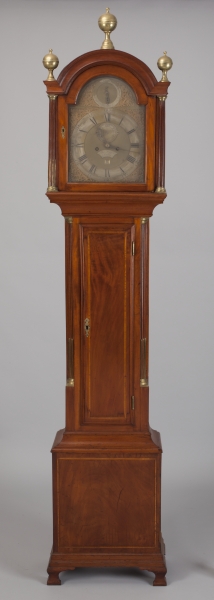
FIG. 12. Tall-case clock; works by Thomas Higgins (active ca. 1749, d. 1766), London, 1740–50; case, Boston, 1790–1800. Mahogany, pine, inlaid woods; h 103¾, w 18⅜, d 9½. Historic New England; Gift of Mary King Longfellow (1945.445).
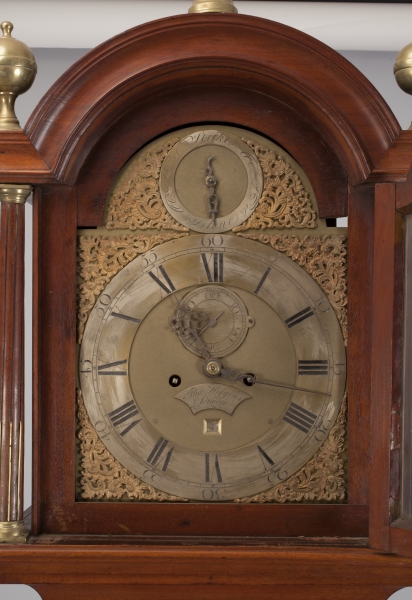
FIG. 13. Dial of the tall-case clock in fig. 12.
A Dutch bombé walnut desk and bookcase of about 1740–50 with a traditional history of ownership by Hutchinson has survived in a private collection; its material and date raise the possibility that it was in the house at the time of the riot.12 The Milton Public Library owns a unique Boston blockfront desk and bookcase, decorated with three surviving gilt busts mounted as finials, that also claims a Hutchinson provenance (figs. 14, fig. 15). The likelihood that the finials were carved by Simeon Skillin Sr. suggests a probable date of 1760–65. The desk is made of Cuban mahogany, however, not the walnut described in the inventory of the “little room,” indicating that the piece was not in Hutchinson’s house at the time of the Stamp Act Riots.13 It seems likelier it belonged in the country house that Hutchinson built in Milton in 1742. Hutchinson’s papers and other valuable objects were removed from Boston to Milton for safe-keeping when Hutchinson was summoned to England in June 1774, following the Boston Tea Party, to consult on Massachusetts affairs. Ironically, the Milton house, which lay behind patriot lines shortly after the battles of Lexington and Concord, was also looted. Even though the Milton Public Library’s desk and bookcase was clearly not part of the furnishings of Hutchinson’s town house in 1765, it does suggest, together with an intricately carved looking glass (fig. 16), owned by the Milton Historical Society, that Hutchinson’s taste leaned toward a high-style opulence. Such luxuries contrasted with the more conservative interior of his town house, which was, after all, an inherited property whose contents would have been assembled over several generations.
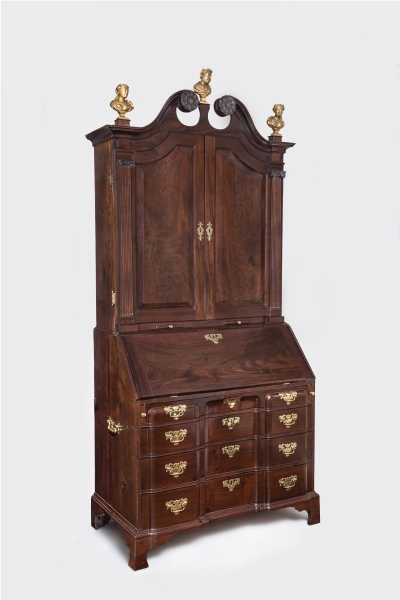
FIG. 14. Desk and bookcase, Boston, 1760–65. Mahogany, white pine; h 96¾, w 43¾, D. 23½. Milton Public Library, Milton, Massachusetts; Bequeathed by Elizabeth Peters Swift. Photo, Gavin Ashworth.
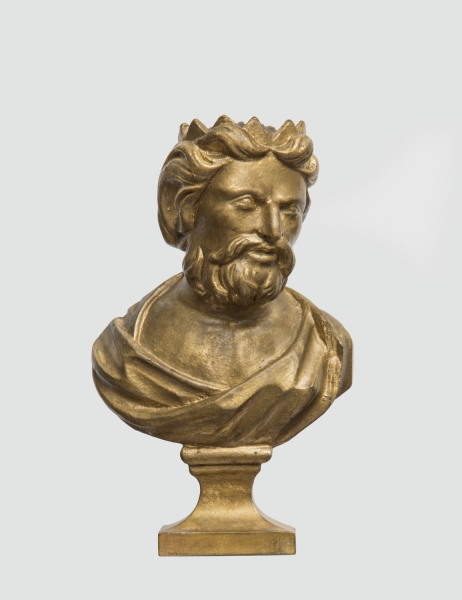
FIG. 15. Finial of desk and bookcase in fig. 14, possibly carved by Simeon Skillin Sr. (1716–1778). Photo, Gavin Ashworth.
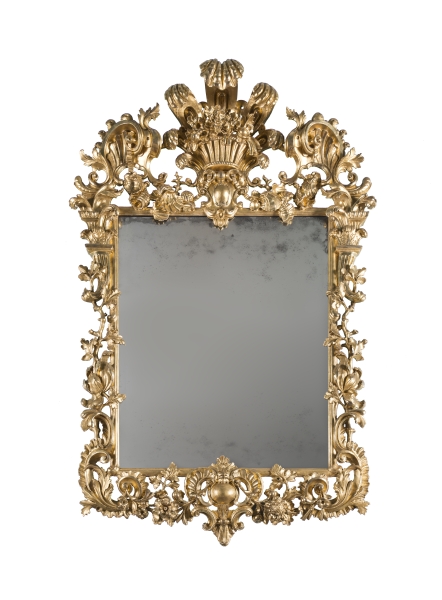
FIG. 16. Looking glass, England or America, 1740–50. Unidentified gilt softwood; h 69¾, w 42⅝, d 3½. Milton Historical Society, Milton, Massachusetts; Gift of Miss Mary Rivers in 1918, conserved in 2010 in memory of Jeannette Peverly. Photo, Gavin Ashworth.
Although Hutchinson does not include books in the inventory of any specific room, he does make a general estimate of £50 for the value of all his books. Unfortunately, he does not detail any titles, other than to mention the loss of a “Universal History.” As chief justice and an amateur historian, he must have owned a well-stocked library of legal reference books, histories, and the classics. The inventory does mention a microscope worth four guineas and a telescope (neither attached to a particular room), suggesting an interest in natural philosophy appropriate to the Age of Enlightenment (table 5).
TABLE 5. ARTICLES NOT APPROPRIATED TO ANY ROOM
|
a large new fashioned silver hilted sword gilt cost 6 guineas blade & hilt broke to pieces & damaged |
3.. |
|
a small silver hilted sword & 2 mourn. swords lost |
4..10 |
|
a chased gold head of a cane & joint 4 Guineas |
5..12 |
|
gold chain & hook of a watch cost 6 guineas |
8..8 |
|
microscope Cost 3 guin. shaving apparatus 1 Guin. |
4..4 |
|
Telescope, razors brushe &c 22/. 2 sets of plate buttons, besides what are saved £4 |
5..2 |
|
a rich cradle & basket with lining of quilted satin & set of laced child bed linnen worth more than |
14.. |
Twelve people were living in the house in 1765, and the value of their apparel suggests much about their status (table 6). Hutchinson was then 54 years old. His beloved wife had died eleven years earlier, and his unmarried sister-in-law Grizzel Sanford (age 45) had come to live with him after her sister’s death to help raise his five children: Thomas Jr. (25), Elisha (22), Sarah (21), William (13), and Margaret (11). There were four servants: Rebeckah Whitmore, the housekeeper; Susannah Townsend, the maid; Moses Vose, the coachman; and Mark, “a negro.”14 In addition, Hutchinson provided a room for a Mrs. Walker, an elderly widow. Where all these people slept is a bit of a puzzle.
TABLE 6. RELATIVE VALUE OF APPAREL
|
Thomas Hutchinson |
156..6..8 |
|
Thomas Hutchinson, Jr. |
48..16..4 |
|
William Sanford Hutchinson |
4..8 |
|
Sarah Hutchinson |
|
|
Margaret Hutchinson |
116..11 |
|
Sister Sanford (sister-in-law) |
181..12 |
|
Rebeckah Whitmore (housekeeper) |
19..1 |
|
Susannah Townsend (maid) |
8..6..4 |
|
Moses Vose (coachman) |
2..7 |
|
Mark (a negro) |
3 |
|
Mrs. Walker (widow) |
11..3..4 |
The “chamber,” or second, floor (fig. 17) had four rooms organized around “the upper entry,” or passage, a sparsely furnished space with just one large and one small table, together with a sideboard. Perhaps these tables stood at the ready in case any of the residents chose to take a meal in their sleeping chamber instead of the hall below.
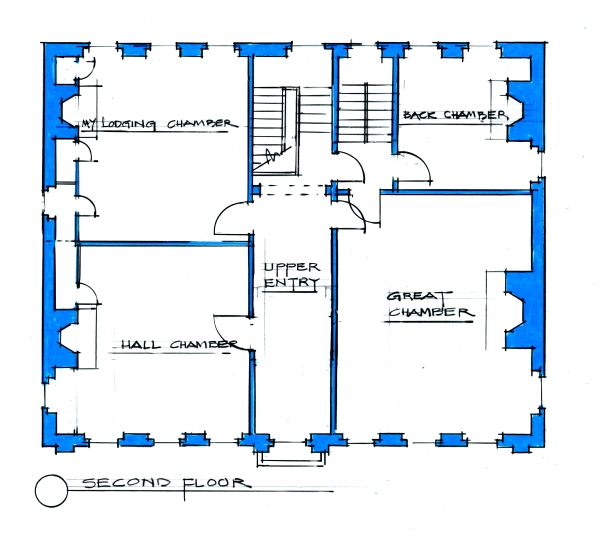
FIG. 17. Conjectural plan of the second floor of the Foster-Hutchinson house. Drawing, Paul Kelly.
The so-called great chamber was, after the parlor, the most expensively furnished room in the house (table 7). Its lavish fittings suggest that it was used as a “state bedroom,” reserved for only the most distinguished guests, although it may also have been a place where the women of the house entertained other female guests for more intimate and less formal visits than those necessitating the opening of the parlor. Setting the tone of luxury were a “crimson damask bed” and “counterpin,” together with window curtains and the backs and seats of eight chairs, perhaps like the one Copley depicted Mrs. Benjamin Hallowell sitting in, all of the same material (fig. 18). (The presence of so many matching chairs strongly suggests that the room was indeed used for entertaining.) Other items in the great chamber contributed an “orientalizing” effect: a japanned15 looking glass and table and “a rich India cabinet very little used with 3 stands of waxworks [figurines] in glasses [or bell jars]” (fig. 19). The cabinet and its contents cost a staggering £38, making it, after the bed hangings, one of the most expensive items in the house. Equally luxurious were the many small objects that lay scattered about on tabletops: a filigree chamber mirror, a large tortoiseshell box, and smaller boxes, combs, and brushes of carved ivory, “very neat and curious.”
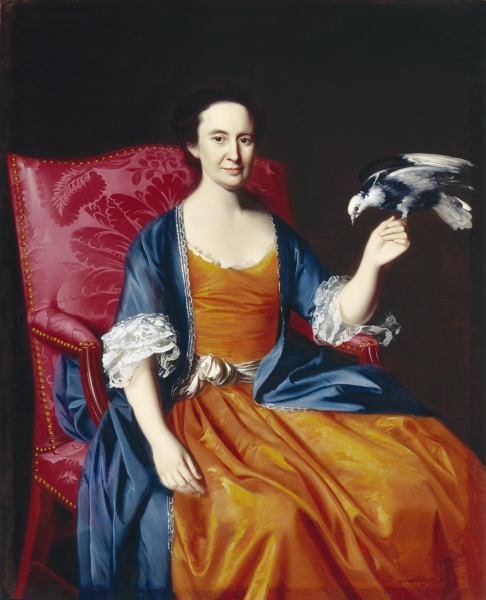
FIG. 18. Mrs. Benjamin Hallowell, John Singleton Copley (1738–1815), Boston, 1766–67. Oil on canvas; h 47, w 37½. Detroit Institute of Arts; Founders Society Purchase, Gibbs-Williams Fund, Dexter M. Ferry Jr. Fund, Robert H. Tannahill Foundation Fund and Beatrice W. Rogers Fund (71.168).
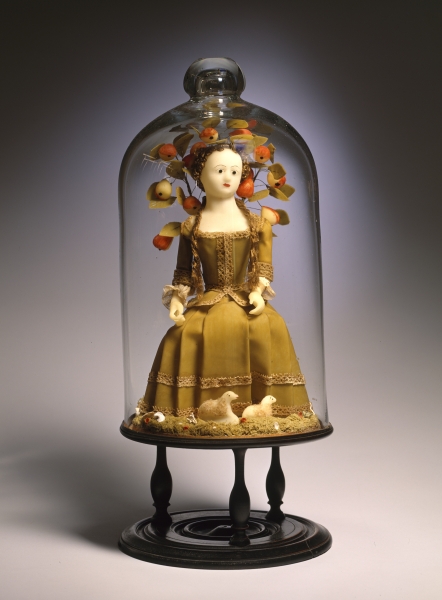
FIG. 19. Wax figure, Sarah Gardner (1709–1794), Boston, 1720–25. Wax, linen, silk, shell, glass, wood; h 23½, d 10½. Historic New England; Gift of Mary C. Stimpson (1924.918).
TABLE 7. GREAT CHAMBER
|
a large looking glass japand frame |
12.. |
|
a rich crimson damask bed counterpin window curtains, 8 chairs covered back & seats with the same & outside coverings part of the curtains only saved, loss more than |
50.. |
|
a rich India cabinet very little used with 3 stands of wax work in glasses |
38.. |
|
a chamber fillegrain dressing glass large tortoise shell box small boxes brushes &c. for a chamber table |
5.. |
|
furniture for another table of carved ivory very neat & curious |
5.. |
|
a japanned square table |
3.. |
|
a small table & toilet |
1..10.. |
|
bed side carpet |
..12.. |
|
Andirons 30/. coat of arms, glazed pictures & glass sconce 70/ |
5.. |
Compared to the opulence of the great chamber, whose value totaled £120, the furnishings in Hutchinson’s “lodging chamber,” worth just £20, were modest, even austere: a chintz bed, a bureau, a small table, some cane chairs, and a harateen easy chair.16 In keeping with the general simplicity of the room, the floor was covered by a Scotch ingrain carpet. In his chamber, Hutchinson also kept boxes for “books & draw[er]s,” another tantalizing reference to the lost library.
The contents of Hutchinson’s bedchamber bear an interesting comparison to the “hall chamber,” by which he means a bedroom located above the first-floor hall. Here were a “very good glass,” “a handsom[e] case of draw[er]s & table” (probably a matching high chest of drawers and dressing table, as seen in fig. 20), “8 cane chairs & silk cushions,” and “a crimson boiled camlet bed lined with silk.”17 The furnishings are not so different from those in Hutchinson’s own room, but the textiles are more luxurious and the adjectives he uses to describe the objects suggest higher quality. In all likelihood, “Sister Sanford” was the occupant of the hall chamber.
FIG. 20. High chest of drawers and dressing table, Benjamin Frothingham Jr. (1734–1809), Charlestown, Mass., 1760–85. High chest: sabicu, mahogany, white pine, red pine; h 87⅜, w 42⅛, d 22. Dressing table: sabicu, mahogany, white pine; h 31⅞, w 33¾, d 20¾. Winterthur Museum; Bequest of Henry Francis du Pont (1967.1445–46).
The last room on the second floor was the “back chamber,” furnished with a green harateen bed, an “old drawers,” and six chairs whose backs and seats were covered with camlet. The total value of the contents was only £5.16. Since Hutchinson detailed elsewhere several items of furniture belonging to his sons, perhaps the back chamber was reserved for his two daughters, both sleeping in the same bed.
Only two other rooms are mentioned specifically in the inventory. One is a “kitchen chamber,” presumably located next to the kitchen so that a servant could keep the fire going through the night. The inventory contains no explicit mention of a kitchen, however, and any ideas about its whereabouts are pure conjecture. The Foster-Hutchinson house, as the 1836 engraving makes clear, sat on a raised basement, so the kitchen may well have been located there or in a separate wing off the back of the house. Hutchinson made no claim for losses related to the kitchen, and indeed elsewhere he suggests that it was largely ignored by looters.
The angry crowd did not overlook the contents of the cellar, however. Hutchinson lost ten pipes18 and four quarter casks of “very good western Island wine”19 and four casks of sherry, worth over £137. Most wine consumed in eighteenth-century America was “fortified,” or strengthened, with brandy to halt the process of oxidation; Hutchinson had nearly £20 worth of unfortified claret and white wine in bottles, none of which were saved. Also hanging in the cellar were a hundredweight of pork, eight hams, and a dozen sides of bacon. The contents of Hutchinson’s cellar were worth substantially more than the furnishings in any other room in the house, including the parlor.
The last room Hutchinson mentions by name is the “chamber over the great chamber,” therefore on the third floor. The occupants of this floor may well have been his three sons and the Widow Walker, whom Hutchinson “had allowed a living in the house several years.” The furniture she brought with her (a featherbed, a looking glass, a walnut table, and a chest of drawers) hint that she had once known better times, but that she had little spare clothing (just one chintz gown) suggests she had become almost indigent (table 8).
|
a feather bed £4.. large glass £4.. |
8.. |
|
chintz gown 21/4 walnut table 18/ |
1..19..4 |
|
chamber table 18/. 4 pr. shoes 12/ |
1..10 |
|
3 pr. clogs 12/. 1 pr. do. 5/4 1 mortar & pestel 4/ |
1..1..4 |
|
3 chairs 9/. 3 glazed pictures 4/ |
..13 |
|
a cambrick apron 13/4 4 holld. shifts 40/ |
2..13..4 |
|
1 muslin apron 10/. 4 good handkerch. 20/ |
1..10 |
|
2 pr. silk hose 18/. 2 pr. cotton 6/ |
1..4 |
|
3 pr. worsted 6/ 2 pr. mits 2/ |
..8 |
|
5 aprons of Irish holland 20/ 16 caps 13/4 |
1..13..4 |
|
3 sheets 20/ 3 pillowbeers 4/ |
1..4 |
|
damage to a case of draws 6/ chest 8/ |
..14 |
|
muff 6/8 3 tablecloths 8/ |
..14..8 |
|
4 pr. cambrick ruffles 6/ 1 Coffee pot 2/8 |
.8..8 |
|
3 curtains |
13..4 |
The inventory that Hutchinson submitted for compensation of his losses reveals the inner workings of a great house in Boston on the eve of the American Revolution. Here were worlds within worlds: the parlor for formal occasions, the great chamber for more informal visits from close friends. Clients might wait in the entry before being shown into the “little room” to meet with the lieutenant governor. Although tables that might be used for private meals stood in almost every room of the house, the hall was apparently reserved for formal dining. The furnishings suggest a household that was rich and comfortable, but perhaps a little old-fashioned and not exactly opulent (except in the great chamber). Real wealth was displayed not so much in cupboards of silver plate as in the bed hangings and clothes carefully folded away in chests of drawers. Untold hours of hand weaving produced brilliant colors and textures that make fashionable twenty-first-century beige interiors appear bland, if not downright dull. Painted oilcloths decorated the floors, while the occasional turkey carpet covering a tabletop provided an accent of exotic elegance.
It took a staff of four to attend adequately to the needs of the eight members of the household, even if two of those members were barely teenagers. Where the staff ate and slept is unclear, perhaps on feather, flock, or hair mattresses that were spread near the kitchen fire during the night and stuffed in closets during the day. Yet, most contemporaries would have found Hutchinson tender-hearted in finding space on the top floor of his home for a neighboring widow in reduced circumstances; otherwise, she would have perhaps been destined to the town’s poor house on the northeast corner of the Common. Behind the baroque facade and full-height pilasters of the Foster-Hutchinson house lay a smooth-functioning machine for living whose inner workings would be revealed only when it was smashed to pieces on the night of August 26, 1765.

1. Thomas Hutchinson, The Correspondence of Thomas Hutchinson, ed. John W. Tyler and Elizabeth Dubrulle (Boston: Colonial Society of Massachusetts, 2014), 1:291.
2. Ibid. Hutchinson had been at work on his three-volume History of the Colony and Province of Massachusetts Bay and had assembled at his house important manuscripts related to the early history of Massachusetts.
3. Hutchinson, Correspondence, 1:335. Three copies of the inventory exist: two are at the Massachusetts Archives and one at the Public Record Office in Kew, England. The first, M-Ar 26:309–20 (hereafter FC1), is entirely in Hutchinson’s hand, while the second, M-Ar 6:301–8 (hereafter FC2) is in both Hutchinson’s and another’s hand with some revisions and rough notes. The third copy was enclosed by Hutchinson in a letter to Henry Seymour Conway, the secretary of state, along with a formal petition to the king for compensation for his losses (Uk-PRO CO5/755 ff. 373–81). FC 1 represents Hutchinson’s first known attempt to itemize his possessions taken from his house on Aug. 26, 1765, as well as those of his family and servants,. From that draft, he proceeded to reorganize the material into FC2, deleting an appeal for the return of missing pages of his manuscript for the History that had concluded the first draft. At some point, Hutchinson made a fair copy (attested by Andrew Oliver on behalf of the council) of FC2 that he enclosed in his letter to Conway. It differs very little from FC2. James Hosmer transcribed FC2 in his biography The Life of Thomas Hutchinson, Royal Governor of the Province of Massachusetts Bay (Boston: Houghton Mifflin, 1896), where it appears as an appendix (351–62). Several minor errors make Hosmer’s transcription unreliable. A new transcription is included in Hutchinson, Correspondence, 1:318–35.
4. See the excellent article by Abbott Lowell Cummings, the dean of colonial New England’s architectural historians, “The Foster-Hutchinson House,” Old-Time New England 54, no. 3 (Jan.–Mar. 1964): 59–76. Cummings explores nearly every aspect of the house’s history, and I am much indebted to his research.
5. Ibid., 69.
6. All values in the inventory are listed in sterling, not the Massachusetts currency of 1765.
7. Cummings, “Foster-Hutchinson House,” 68.
8. Some scholars regard burnt china as a generic term for all Chinese export; others reserve it for Japanese Imari, porcelain with a blue underglaze decorated by a second glazing of red or white, with decorative gilding.
9. Cummings, “Foster-Hutchinson House,” 63.
10. See invoice in Hutchinson, Correspondence, 1:418–19.
11. Pile woven upholstery from England whose designs were reminiscent of “turkey” carpets, or oriental rugs.
12. See Walter Muir Whitehill, Jonathan L. Fairbanks, and Brock Jobe, eds., Boston Furniture of the Eighteenth Century: A Conference Held by the Colonial Society of Massachusetts, 11 and 12 May 1972, Publications of the Colonial Society of Massachusetts, vol. 48 (Boston: Colonial Society of Massachusetts, 1974), 150–53, fig. 103.
13. Robert Mussey (conservator) to Glen Coffman and Herbert Wotiz, Boston, Jan. 5, 1995, Milton Public Library, Milton, Mass.
14. Although enslaved domestic help was common in elite Boston households of the time, the Massachusetts tax list of 1771 does not record Hutchinson as owning any slaves. Mark may have been a free servant, although the designation “Negro” was often used as an alternate way of describing someone as a slave.
15. Japanning involved applied gesso ornaments of Asian designs under many layers of paint and varnish. For more on the process, see the essay by Tara Hingston Cederholm and Christine Palmer Thomson in this volume.
16. Harateen was one of the most common fabrics for upholstery, usually in green, yellow, blue, red, or tan (cloth color). Florence M. Montgomery, Textiles in America, 1650–1870: A Dictionary Based on Original Documents, Prints and Paintings, Commercial Records, American Merchants’ Papers, Shopkeepers’ Advertisements, and Pattern Books with Original Swatches of Cloth (New York: W. W. Norton, 1984), remains the authoritative source, and the book has been reissued in a revised edition with a foreword by Linda Eaton (2014).
17. “Boiling” a fabric cleansed it of grease and oil, rendering it fluffier and better able to receive dyes. Camlet was originally camel’s hair, but by this time it was made of worsted wool or a blend of angora goat’s hair and silk.
18. A wine cask with a capacity of 126 gallons.
19. The produce of the Western Islands, now known as the Azores.

